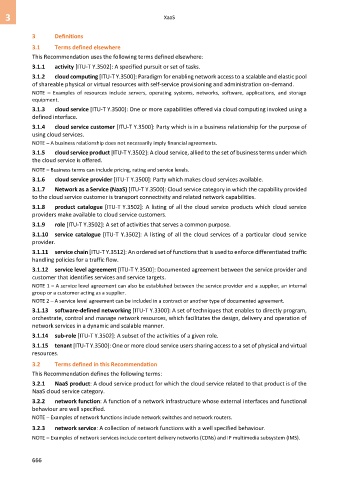Page 674 - Cloud computing: From paradigm to operation
P. 674
3 XaaS
3 Definitions
3.1 Terms defined elsewhere
This Recommendation uses the following terms defined elsewhere:
3.1.1 activity [ITU-T Y.3502]: A specified pursuit or set of tasks.
3.1.2 cloud computing [ITU-T Y.3500]: Paradigm for enabling network access to a scalable and elastic pool
of shareable physical or virtual resources with self-service provisioning and administration on-demand.
NOTE – Examples of resources include servers, operating systems, networks, software, applications, and storage
equipment.
3.1.3 cloud service [ITU-T Y.3500]: One or more capabilities offered via cloud computing invoked using a
defined interface.
3.1.4 cloud service customer [ITU-T Y.3500]: Party which is in a business relationship for the purpose of
using cloud services.
NOTE – A business relationship does not necessarily imply financial agreements.
3.1.5 cloud service product [ITU-T Y.3502]: A cloud service, allied to the set of business terms under which
the cloud service is offered.
NOTE – Business terms can include pricing, rating and service levels.
3.1.6 cloud service provider [ITU-T Y.3500]: Party which makes cloud services available.
3.1.7 Network as a Service (NaaS) [ITU-T Y.3500]: Cloud service category in which the capability provided
to the cloud service customer is transport connectivity and related network capabilities.
3.1.8 product catalogue [ITU-T Y.3502]: A listing of all the cloud service products which cloud service
providers make available to cloud service customers.
3.1.9 role [ITU-T Y.3502]: A set of activities that serves a common purpose.
3.1.10 service catalogue [ITU-T Y.3502]: A listing of all the cloud services of a particular cloud service
provider.
3.1.11 service chain [ITU-T Y.3512]: An ordered set of functions that is used to enforce differentiated traffic
handling policies for a traffic flow.
3.1.12 service level agreement [ITU-T Y.3500]: Documented agreement between the service provider and
customer that identifies services and service targets.
NOTE 1 – A service level agreement can also be established between the service provider and a supplier, an internal
group or a customer acting as a supplier.
NOTE 2 – A service level agreement can be included in a contract or another type of documented agreement.
3.1.13 software-defined networking [ITU-T Y.3300]: A set of techniques that enables to directly program,
orchestrate, control and manage network resources, which facilitates the design, delivery and operation of
network services in a dynamic and scalable manner.
3.1.14 sub-role [ITU-T Y.3502]: A subset of the activities of a given role.
3.1.15 tenant [ITU-T Y.3500]: One or more cloud service users sharing access to a set of physical and virtual
resources.
3.2 Terms defined in this Recommendation
This Recommendation defines the following terms:
3.2.1 NaaS product: A cloud service product for which the cloud service related to that product is of the
NaaS cloud service category.
3.2.2 network function: A function of a network infrastructure whose external interfaces and functional
behaviour are well specified.
NOTE – Examples of network functions include network switches and network routers.
3.2.3 network service: A collection of network functions with a well specified behaviour.
NOTE – Examples of network services include content delivery networks (CDNs) and IP multimedia subsystem (IMS).
666

